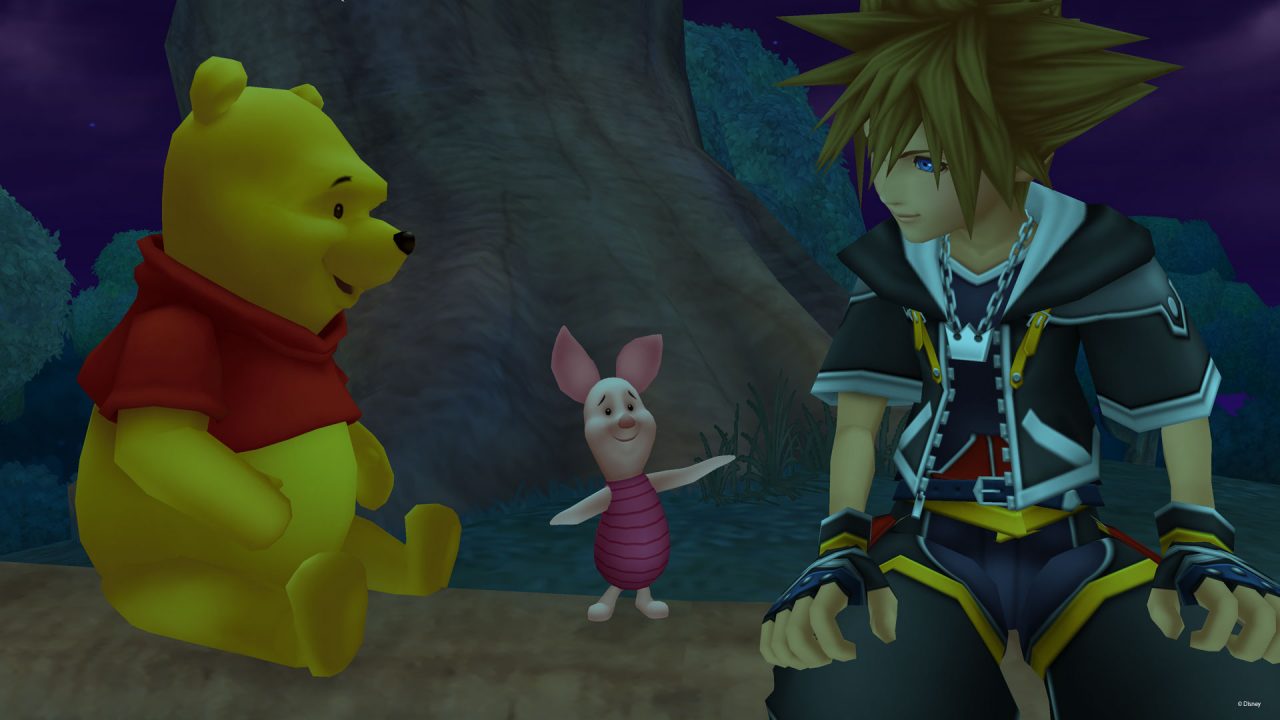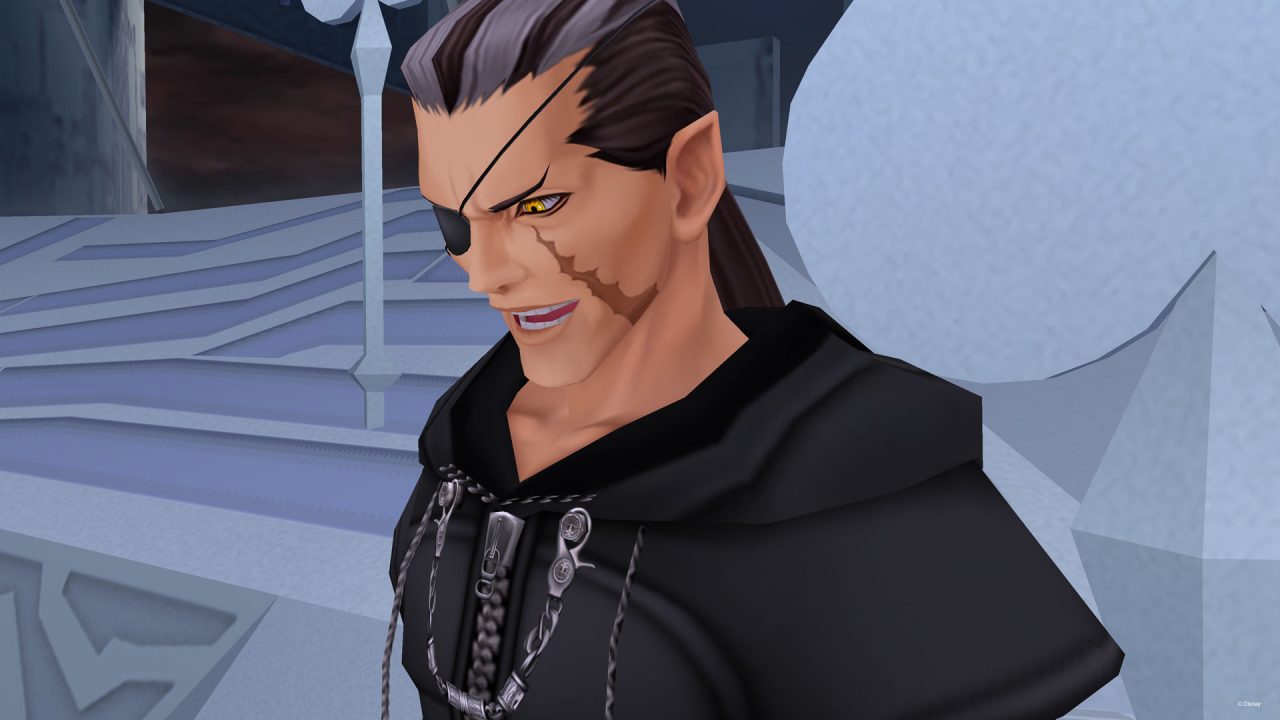Coming off the heels of two widely successful games, Kingdom Hearts II had a high bar to meet upon its release in 2005. More than meeting expectations, it was critically lauded and, like Kingdom Hearts before it, later received a definitive Final Mix re-release, which did not see Western gaming audiences until 2014 as part of Kingdom Hearts 2.5 HD ReMIX. Some years later, it is worth re-examining Kingdom Hearts II: Final Mix and seeing how well the sequel’s various aspects hold together, especially considering its pioneering influence in popularizing and revolutionizing the ARPG genre.
Kingdom Hearts II opens with an entirely new character, Roxas, in an unfamiliar location, Twilight Town. Here, he spends time with his friends during the last week of a waning summer vacation. The town, with its peaceful music and tranquil atmosphere, begins to experience strange happenings: citizens suddenly can’t say certain words, thieves are on the loose, and the world begins freezing, stuttering, and behaving unusually. Worse yet, peculiar grey monsters start appearing, as do strange characters in black cloaks, who are seemingly after Roxas.
To add to the disarray, the screen fades away occasionally into static, cutting to scenes from the first Kingdom Hearts and to shadowy figures who spout unfamiliar jargon, talking of “The Organization’s interference” and of restoring and waking a sleeping Sora, the first game’s protagonist. Eventually, Roxas discovers that he is in a simulation and, fighting his way down into a mysterious mansion, he finds Sora asleep in a pod and realizes that his existence is now null and void, lamenting, “I guess my summer vacation is over.” Fade to white and cue the title.
Spanning a few hours, this atmospherically daring opening segment drastically differs from the first game. While the tutorials are a bit lengthy, it is an engrossing opening and firmly establishes the game’s more mature tone and identity. It carries a somber, dreamlike, and unusual mood that beautifully sets up an unbelievable amount of intrigue as to what just happened. This is especially true if one has not played the more obscure GBA intermission, Chain of Memories, which helps to partially explain some of the opening’s events.
After Sora wakes up alongside Donald and Goofy, the reunited trio embarks into the real Twilight Town, notes the continued existence of the Heartless, and eventually sets off to various Disney worlds to discover the truth behind the “Organization” and find their missing friends. Along the way, a newly resurrected Maleficent and her minion, Pete, harness an army of Heartless and terrorize Sora and company throughout the journey.
The remainder of the plot and the overarching adventure that ensues, for the most part, is serviceable. However, in the context of its extraordinarily promising and compelling opening, it feels like a colossal letdown which suffers from atrocious pacing. The story sees Sora slipping into various worlds—some old, some new—each with a largely self-contained plot. Each area usually contains brief, unrelated bouts of shenanigans from the largely irrelevant and dull Maleficent and Pete or, more interestingly, the Organization.
While Kingdom Hearts’ worlds feel like lovingly crafted homages to the source material, each with their own unique designs and semi-original adventures, Kingdom Hearts II’s are significantly more derivative. This staleness often combines with a level-design dominated by linearity and lack of detail or surprises, which reduces the potential for exploration. Most of these worlds aren’t terrible or even necessarily bad, though. Visually, the game’s levels are gorgeously crafted, and each area and its characters are, for the most part, accented by top-quality voice acting that keeps the various worlds interesting, at least on a surface level.
The Timeless River world exhibits the series’ Disney-based content at its absolute best, with the bit-crushed sound effects, classic animation design, and old-timey cartoon-based Heartless enemies all combining to form a smile-inducing, adorable level topped off with a genuinely creative, slapstick-like boss fight with Pete.
On the flipside, the Pirates of the Caribbean level sees Sora trudging through a rehashed, condensed—but still somehow exhaustingly long—retelling of The Curse of the Black Pearl with a voice actor for Captain Jack Sparrow who is clearly not Johnny Depp, but is trying very hard to be. And while the world independently looks fantastic, it clashes with the game’s art style in a peculiar, jarring way. Irrespective of the admittedly fun, bombastic Pirates of the Caribbean battle theme, this area is indicative of Kingdom Hearts II at its worst: an amusing but ultimately cheap theme park ride.
Nevertheless, the story and overall game have interspersed sparks of intrigue, especially towards the midpoint and ending. While some of this has to do with finally delivering on plot and character moments (to varying effects), Kingdom Hearts II’s true ascent into greatness is through its combat and gameplay.
Being significantly more action-oriented and leaning more into the “A” in ARPG, Kingdom Hearts II plays considerably faster and grants a wider plethora of combat options than its predecessor. This game introduces two new mechanics: Reaction Commands and Drive Forms.
Reaction Commands are time-sensitive and context-based events where, if you hit triangle, Sora will perform a highly choreographed special attack. The various enthralling somersaults, flips, and slides are a joy to execute, and help keep combat encounters fresh and exciting. While they become a bit too prevalent or overpowered at points, they are a net positive, especially in elevating the game’s various, mostly exciting boss fights.
On the other hand, Drive Forms are unique, specialist-based forms Sora acquires throughout the game and, by using the “Drive Meter,” which fills up from defeating enemies, Sora can transform into one of the various forms, each with their own special attacks and movement abilities. For example, the red-colored Valor Form increases Sora’s jump and enables dual-wielding Keyblades for maximum physical offensive output, whereas the blue-colored Wisdom Form allows Sora to dodge faster and further, skate around, shoot rapid-fire magic bullets, and use more powerful magic spells. Functionally, these forms are beyond useful; switching to Valor Form and completely obliterating a group of enemies is ridiculously fun, and these are easily the game’s biggest mechanical highlight.
Like the first game, you also have powerful summons; however, they now use the Drive Gauge and stay on the field in place of Donald and Goofy. While there are only four summons, each one is deliberately designed for a specific gameplay niche and their unique, toggleable, and powerful abilities help them to stand out.
Both magic and Limits use an MP bar that goes through a recharging period dubbed “MP Charge,” which, once exhausted, leaves Sora unable to use magic. While both are powerful tools, curative magic and Limits fully exhaust the MP bar no matter how full it is, which is a smart decision to curb spamming magic and maintain game balance. The sheer number of approaches you have for combatting various enemies and bosses throughout each level lends the game an incredible amount of replay value and variety, and it is thoroughly engaging.
That said, the execution of the combat in some later sections of the game does leave a bit to be desired, which will likely be evident for players more skilled with ARPGs. The game’s balance, especially on easier difficulties, falls exponentially within regular combat encounters about halfway through. While the Critical Mode difficulty alleviates this significantly due to starting you out with better movement and combat abilities, there is a clear and stark divorce between the game’s skill floor and ceiling, which leaves the overall experience uneven and difficult to tailor without some foreknowledge.
Even so, Kingdom Hearts II delivers masterful culminations of its combat mechanics throughout, elevating the game to stratospheric heights. Numerous boss fights are breathtaking, and the battle against 1,000 Heartless enemies at the game’s midpoint, beyond being a technical marvel for the PS2, is a stunningly thrilling encounter.
Further, every Organization boss fight—several of which are exclusive to the Final Mix edition—is a unique, themed encounter that forces utilization of your entire arsenal, and all of them stand out as special and memorable. Particularly, the postgame refights against Organization XIII and the game’s two superbosses are some of the greatest, most thrilling boss fights in any video game to date, period.
Kingdom Hearts II’s standout moments and fights shine even brighter due to Yoko Shimomura’s magnificent score, especially with the robust orchestrated tracks in the 2.5 HD Remix. This game is a case study in Yoko Shimomura’s masterful conveyance of emotional depth through music; “A Fight to the Death” spins with dizzyingly exhilarating piano flourishes paired with sweeping, dueling string sections evocative of the intense battle it plays in. The theme of Roxas, especially in “The Other Promise,” exudes existential torment, rage, and devastation with frantic, rollercoaster-like piano crescendos and mournfully insistent flutes. If players come away with a powerful emotional impact from the characters, Shimomura’s score is a major reason why.
All in all, Kingdom Hearts II is a tremendous accomplishment, and while it occasionally fails in consistently executing at the absolute highest level on its best elements, especially regarding the plot and worlds, it remains consistently engaging due to its high production value, riveting gameplay, stellar boss fights, and superb postgame content. For anybody who loves and appreciates ARPGs, it is a foundationally tremendous, if slightly imperfect, titan of the genre.





